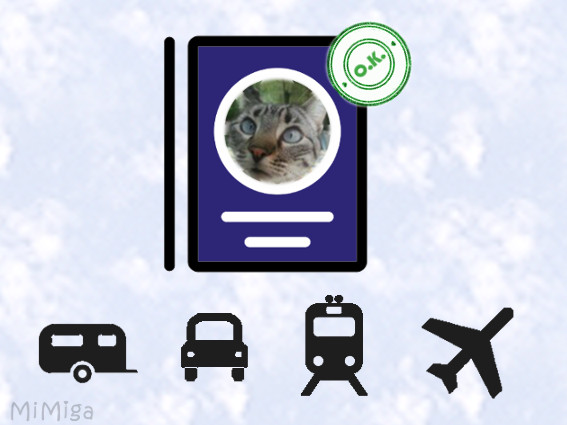
Considerations & Conditions
If you consider travelling with your cat(s) or other pet animals, you might have to prepare for it, considering a few things:
The decision to travel with a cat, depends amongst other factors, on his caracter, the vehicle of transport and the duration. For short trips most cats prefer staying in their habitual environment. This doesn't mean that there are no cats accustomed to travel in caravan or enjoying vacations in a place familiar to them.
In general it's advisable for your cat(s) to have a microchip and the vaccination history up-to-date, because during a possible escape and can enter en contact with other animals.
For travel on public transport, please consult previously with your national train network or the chosen airline their particular conditions.
If you travel by plane it is advisable to book for your pet in advance to travel in cabin. Not all airlines and airports treat animals with the care they should.
Travelling in Europe - Legal requirements
To travel around Europe your cat must be identified by an electronic identification system (transponder), which is ALWAYS recommendable, even for sheer house cats, and without travelling) and be accompanied by the European Pet Passport (compulsory since 2012).
An anti-rabies vaccination in vigor (minimum 30 days and less than a year before the journey) with previously implanted microchip is also required.
Several member countries allow the entry with kittens under 3 month if they are provided with a microchip, a European Pet Passport and a veterinarian certification that states that they " have stayed in the place in which they were born since birth without contact with wild animals likely to have been exposed to the infection" or are accompanied by their mothers on whom they are still dependent.
More information on the European Union's website, where you can check out the national rules applying to entry pets of less than 3 month non-vaccinated against rabies of all Member States.
Tips & Tricks
To avoid nauseas and vomiting do not feed your cat 4-6 hours prior to the departure. There also exist medicines against travel sickness, pheromones and special animal foods to treat stress. Please consult your vet!
During the whole journey we should be extra careful and not forget that the cat (generally) finds himself in a strange situation and could react differently.
To prevent that our cat may be lost in a moment of distraction we can equip him/her with a security collar or, even better, a harness and a leash during the travel. Important: Practice PREVIOUSLY at home! And as the microchip only can be detected by a special reading device, we can fix an identification capsule or medal with our contact information at the collar/harness. Make also sure that that the transponder number has been registered.
Parting from my own experience I recommend to use an harness, even for flights, with your cat in a carrier, because during the check-in control you'll have to take him/her out, and that - in an airport with a lot of people, noises and strange odours - could result dangerous, even with a couch potato.
If you journey for a longer time in car or caravan a harness and leash will also help you control your cat during the stops. And once arrived at destination you can give him/her a little bit of freedom putting a stake next to your van, with a large or self retractable leash hooked onto the harness (please ALWAYS ONLY under your vigilance, to avoid entanglements and the risk of strangulation). If you stay longer in one place it's quite better to fix a long line between two elevated spots and attach the leash to it.For real 'Houndinis' under the cats you might take into consideration the purchase of a gps for cats.
More on security during the journey, pet friendly accomodations, how to prevent and treat a heat stroke... on Holiday - Not without my cat!
MiMiga wishes you a pleasant travel and a happy return.
